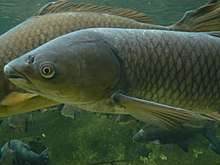Squaliobarbinae
Squaliobarbinae is a small subfamily of the carp and minnow family, Cyprinidae, which consists of three monotypic genera which have their natural distributions in eastern Asia. Two species, the grass carp (Ctenopharyngodon idella) and the black carp (Mylopharyngodon piceus), have been introduced to other parts of the world for weed control and aquaculture. They are large cyprinids which are characterised by an enlarged subtemporal fossa, the palate articulating with the supraethmoid, an enlarged intercalar bone in the cranial vault and a divided levator posterior muscle.[2]
| Squaliobarbinae | |
|---|---|
 | |
| Mylopharyngodon piceus | |
| Scientific classification | |
| Kingdom: | Animalia |
| Phylum: | Chordata |
| Class: | Actinopterygii |
| Order: | Cypriniformes |
| Family: | Cyprinidae |
| Subfamily: | Squaliobarbinae Howes, 1981[1] |
Genera
The three genera which make up the subfamily Squaliobarbinae are:[3]
| Image | Genus | Living Species |
|---|---|---|
 | Ctenopharyngodon Steindachner, 1866 |
|
 | Mylopharyngodon Peters, 1881 |
|
 | Squaliobarbus Günther, 1868 |
|
Taxonomy
Cyprinids are a large, widespread and diverse family of, mainly, freshwater ray-finned fish and the taxonomy of the family has not yet been fully resolved. Fishbase recognises Squaliobarbinae as a valid subfamily but recent studies suggest that this may not necessarily be the case in the future. For example, the three genera of this subfamily have been placed in the larger subfamily Oxygasterinae and Squaliobarbinae is listed as a synonym of Oxygasterinae in a 2013 paper by Tang, Lumbantobing & Mayden.[1] and the World Register of Marine Species treats all three taxa traditionally placed in Squaliobarbinae as incertae sedis.[4] while the Catalog of Fishes places them in the subfamily Xenocyprinae.[5] However, at whatever level they are classified the three squaliobarbine taxa appear to be closely related and to form a clade.[6] and have been referred to as the tribe Squaliobarbini.[7]
References
- Kevin L. Tang; Daniel Lumbantobing; Richard Mayden (2013). "The Phylogenetic Placement of Oxygaster van Hasselt, 1823 (Teleostei: Cypriniformes: Cyprinidae) and the Taxonomic Status of the Family-Group Name Oxygastrinae Bleeker, 1860". Copeia. 2013 (1): 13–22. doi:10.1643/cg-10-121.
- Joseph S. Nelson; Terry C. Grande; Mark V. H. Wilson (2016). Fishes of the World (partial). John Wiley & Sons. ISBN 978-1119220824.
- Riner Froese; Daniel Pauly, eds. (2017). "Subfamily: Squaliobarbinae". Fishbase. Retrieved 9 December 2017.
- "Cyprinidae Rafinesque, 1815". World Register of Marine Species. Retrieved 9 December 2017.
- William Eschmeyer (ed.). "Catalog of Fishes". California Academy of Sciences. Retrieved 9 December 2017.
- He, Shunping; Mayden, Richard L.; Wang, Xuzheng; et al. (2008). "Molecular phylogenetics of the family Cyprinidae (Actinopterygii: Cypriniformes) as evidenced by sequence variation in the first intron of S7 ribosomal protein-coding gene: Further evidence from a nuclear gene of the systematic chaos in the family". Molecular Phylogenetics and Evolution. 46 (3): 818–29. doi:10.1016/j.ympev.2007.06.001. PMID 18203625.
- Richard van der Laan; William N. Eschmeyer; Ronald Fricke (2014). "Family Group Names of recent Fishes". Zootaxa. 3883 (2): 001–230. doi:10.11646/zootaxa.3882.1.1. PMID 25543675.